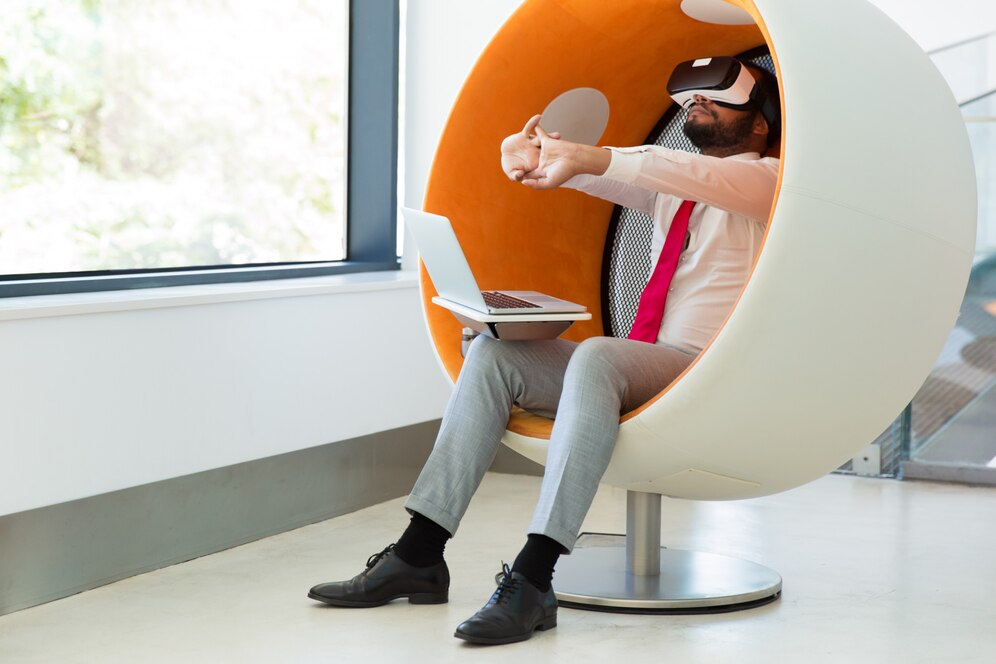Revolutionizing Remote Work: Virtual Reality Meeting Platforms
Due to the COVID-19 pandemic, more companies have sent their workers home to work remotely, but communication issues can easily arise without the benefit of face-to-face contact. Thankfully, due to VR technology becoming more accessible to mainstream markets, companies can take advantage of virtual reality meeting room software. These apps are designed to create immersive and interactive settings that make it feel like the employees are all back together in the same building once more. Since remote work has become the new normal, companies have jumped on the opportunity to create an immersive virtual reality conference room to help workers be more productive and give them the benefit of interactivity.
In today’s fast-paced digital world, remote work has become more than just a trend—it’s a necessity for many businesses. Traditional video conferencing tools have served us well, but as we dive deeper into the 21st century, a new player enters the arena to transform our remote collaboration experience: Virtual Reality (VR). Virtual reality meeting platforms are changing the way professionals connect, collaborate, and communicate across distances. Let’s delve into how these platforms are making virtual reality meetings an essential tool for businesses worldwide.
What Are Virtual Reality Meeting Platforms?

Virtual reality meeting platforms use VR technology to produce immersive meeting spaces where participants may engage as though they were in the same actual location. Virtual reality meetings provide a three-dimensional environment where participants may move, interact with virtual objects, and feel a sense of presence that is unmatched by regular video conferences. Principal features of virtual reality meeting platforms consist of:
- 3D Avatars: Participants are represented by customizable avatars, providing a personal touch.
- Interactive Environments: Users can manipulate objects, review 3D models, and even write on virtual whiteboards.
- Spatial Audio: Audio in VR meetings is directional and spatial, enhancing the feeling of being in the same room.
- Integration with Traditional Tools: Many virtual reality meeting platforms integrate with existing enterprise tools like Slack, Microsoft Teams, and Google Workspace.
Benefits of Using Virtual Reality Meeting Platforms
The adoption of virtual reality meeting platforms offers numerous benefits for businesses looking to innovate their communication and collaboration methods:
- Enhanced Engagement: The immersive nature of virtual reality meetings helps maintain participant engagement, reducing distractions common in traditional online meetings.
- Improved Collaboration: Virtual reality allows for more natural interactions, which can lead to more effective brainstorming and problem-solving.
- Scalability: Virtual reality platforms can accommodate small team meetings to large-scale conferences, all within customizable virtual environments.
- Accessibility: These platforms can be accessed from anywhere, making them perfect for global teams and remote workers.
Real-World Applications and Data
According to a study by PwC, companies using virtual reality technologies, including virtual reality meeting platforms, can expect a 23% increase in productivity. Furthermore, businesses have reported up to a 30% reduction in travel costs after shifting to virtual reality meetings for regular check-ins and stakeholder meetings.
How Do Virtual Reality Meetings Work?

Virtual reality (VR) meetings offer immersive experiences where participants interact in a simulated environment. To engage in such meetings, users require specific hardware, software, and access to VR meeting applications. Below is a detailed guide on how virtual reality meetings function and how to set them up effectively.
Hardware and Software Requirements
To partake in virtual reality meetings, individuals need the following:
- VR Headset: A device that tracks head movements and displays virtual environments in 3D. Examples include Oculus Quest, HTC Vive, or Valve Index.
- Compatible PC or Smartphone: Some VR headsets require a powerful PC to connect to, while others operate independently or connect to smartphones for processing.
- VR Meeting Application: Software platforms such as VRChat, AltspaceVR, or custom enterprise solutions facilitate virtual meetings by providing interactive environments and communication tools.
Entering a Virtual Meeting Room
Once equipped with the necessary hardware and software, participants can join virtual meetings by following these steps:
- Launch the VR Meeting Application: Open the chosen VR meeting application on the VR headset or the connected device.
- Select or Create a Room: Users can choose from existing virtual meeting spaces or create new ones, depending on the platform’s features.
- Enter the Meeting: Upon selecting a room, participants are transported into the virtual environment, where they appear as avatars representing their physical presence.
- Interact with Attendees: Within the virtual meeting room, users can see and communicate with other attendees’ avatars using voice chat or text communication.
Setting Up Your First Virtual Reality Meeting
To organize a successful virtual reality meeting, follow these steps:
- Choose a Platform: Evaluate and select a VR meeting platform that aligns with your requirements. Consider factors such as available features, user interface, and compatibility with your VR hardware.
- Hardware Requirements: Ensure that all participants have the necessary VR hardware and software installed before the meeting. Provide guidance or support to users who may need assistance setting up their devices.
- Scheduling: Utilize integrated scheduling tools within the VR meeting platform to set up meetings and invite participants. Ensure that meeting times accommodate participants’ time zones and availability.
- Customization: Customize the virtual meeting space to suit the meeting’s purpose and participants’ preferences. This may include adjusting the layout of the virtual environment, incorporating interactive elements, or branding the space with company logos or themes.
Choosing the Right Virtual Reality Meeting Platform
When selecting a virtual reality meeting platform, consider the following factors to ensure it meets your business needs:
- Compatibility: Check hardware and software requirements.
- Features: Look for essential features like integration capabilities, scalability, and user-friendliness.
- Security: Ensure the platform has robust security measures to protect sensitive business information.
- Support: Opt for platforms with reliable customer support for troubleshooting and assistance.
Conclusion
Virtual reality meeting platforms are paving the way for a new era of remote communication, offering immersive, efficient, and engaging ways to connect with colleagues and clients globally. As technology advances, these platforms will continue to evolve, further enhancing our ability to conduct business across virtual spaces. Whether integrating into existing digital strategies or exploring VR for the first time, businesses stand to gain significant benefits from adopting virtual reality meetings into their communication arsenals.
FAQ
A: While virtual reality meetings offer unique advantages, they complement rather than replace traditional methods, serving different needs and preferences.
A: Initially, the setup cost for virtual reality hardware can be high, but the long-term savings on travel and increased productivity often justify the investment.
A: Reputable virtual reality meeting platforms implement strong security protocols, but it’s crucial to review each platform’s security measures and ensure they align with your company’s standards.
A: Yes, most virtual reality meeting platforms are designed to be user-friendly. However, some users might experience discomfort or motion sickness, which is typically addressed with adjustments to the virtual environment or shorter session times.